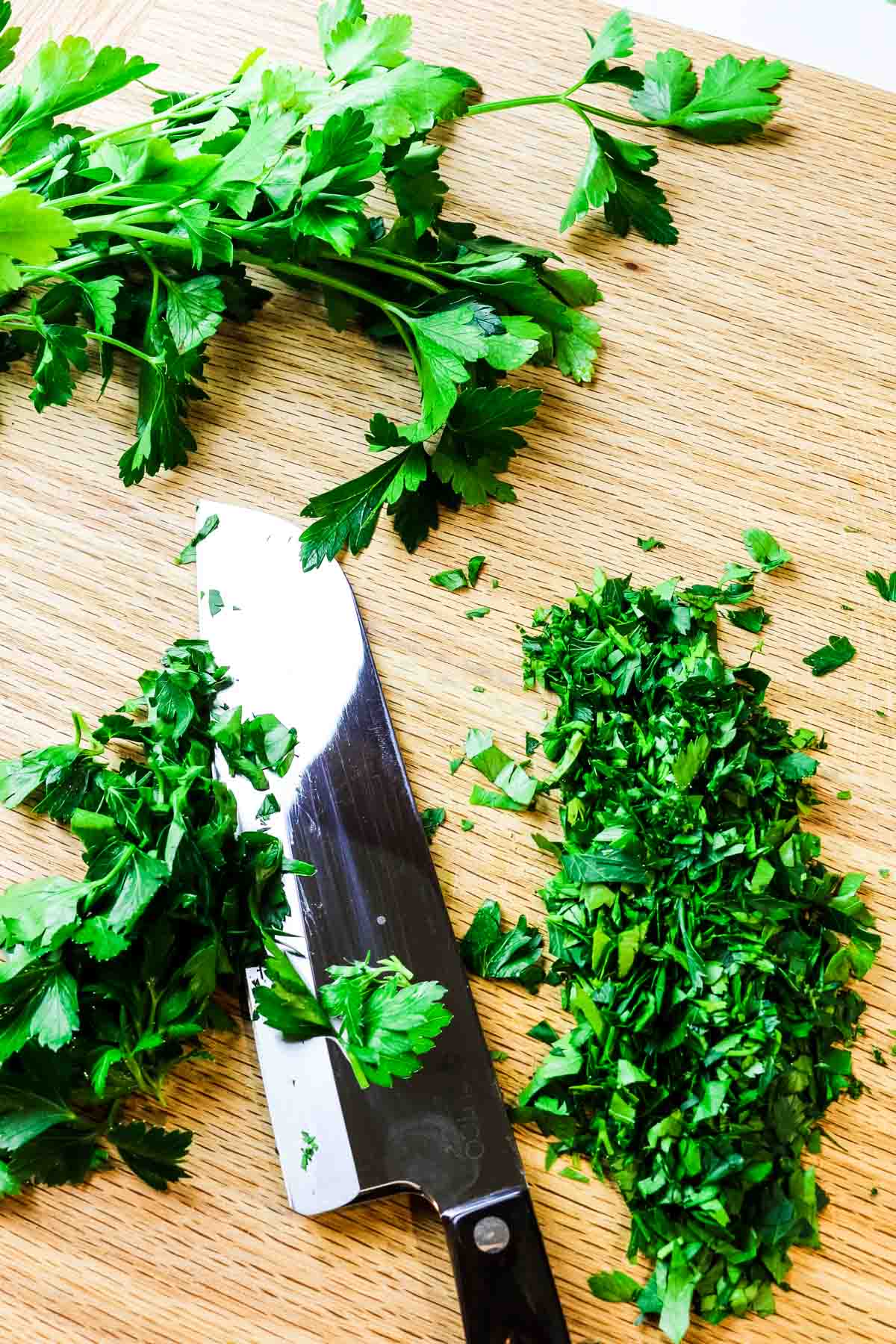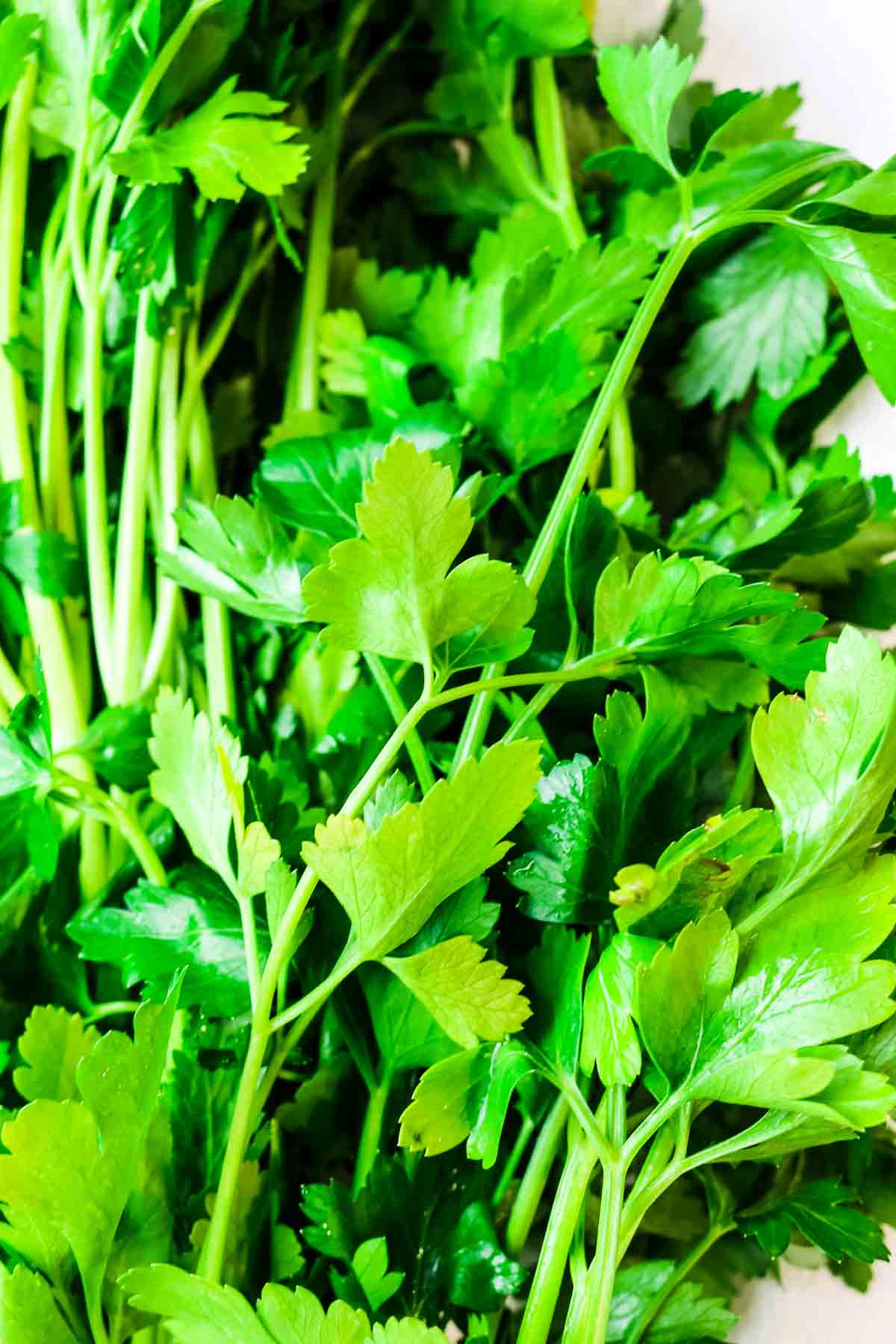Learn how much dried parsley to substitute for fresh parsley to ensure your recipes are flavorful and well-balanced. Plus, find out when to best use fresh parsley and when dried is needed. This unique herb has a different density and volume than other herbs; therefore, the conversion ratio is slightly different.
Fresh parsley is a fragrant herb used in various dishes. It adds a bright and fresh flavor to everything from soups to salads. Its an excellent garnish to red cabbage steaks and chicken potato bake and adds great flavor to the overall dish.
However, due to convenience or availability, you may need to reach for dried parsley instead of fresh.
In some cases, dried herbs have a stronger flavor; thus, they are a convenient option for recipes requiring longer cooking times. The good news is that theres an easy to determine how to make this simple switch.[feast_advanced_jump_to]

Easy Formula for Most Herbs
The general rule of thumb for substituting dried herbs for fresh is to use one-third the amount of dried herbs as you would use fresh herbs.
For example, you can use one teaspoon of dried equivalent for one tablespoon of fresh herbs. Note: there are three teaspoons in a tablespoon.
But this fresh-to-dried herb converter doesnt work perfectly with all types of herbs. Different herbs have different conversion ratios. And as you will quickly learn, fresh to dried parsley conversion is different.
So why do fresh-to-dried herb conversion ratios differ?
In short, the drying process affects the conversion ratio of fresh to dried herbs. Drying herbs removes the water content, which concentrates the flavor and aroma of the herb.
As a result, you would need a lesser quantity of dried herbs to produce the same flavor profile as fresh.
Plus, herbs have varying degrees of density and volume. Herbs that are lighter and more dense, such as thyme or rosemary, require less dried herbs to achieve the same flavor as fresh ones.
Conversely, larger volumes and less dense herbs, like fresh basil, parsley, or cilantro, require a 1:1 or 1:2 conversion ratio to achieve the right flavor.
To complicate things further, the amount used will also vary depending on the recipe and your personal preference. When it comes to herbs, measure with your heart and adjust as needed to achieve the desired flavor and aroma.

Is Dried Parsley the Same as Fresh Parsley?
Dried parsley is different from fresh parsley. While both come from the same plant, the flavor, texture, and nutritional content differ.
Fresh parsley has a bright, herbaceous flavor, while dried parsley has a more muted and concentrated flavor.
In terms of texture, fresh parsley is crisp and delicate, while dried parsley is brittle and crumbly.
Nutritionally, fresh and dried parsley are similar in vitamin and mineral content. (source) The most significant benefit of using dried parsley is that it has a longer shelf life. Plus, it is a convenient option for recipes that require longer cooking times.

Is it okay to use dried herbs instead of fresh ones? And what would make a good fresh parsley substitute?
Generally, it is okay to use dry herbs instead of fresh ones. However, its essential to remember that the flavor and aroma of dried herbs are more concentrated than their fresh counterparts.
The same is true as it relates to the flavor of parsley. Plus, there can be a few different forms of parsley: fresh, dried, and even frozen. In most cases, they are interchangeable. Therefore, dried parsley makes a fantastic substitute for fresh, adding a robust taste to your dish.

How to Dry Parsley
FAQ
What is 1 4 cup fresh parsley equal to dry?
What is the equivalent of 1 4 cup fresh dill to dried?
How many tablespoons is 1 4 cup fresh parsley?
How much dried parsley equals fresh parsley?
How many tablespoons of fresh parsley in 1/4 cup?
In general, 1 tablespoon of fresh parsley is equivalent to 1 teaspoon of dried parsley. Therefore, 4 tablespoons of dried parsley will be needed to equal 1/4 cup of fresh parsley. It’s important to note that the conversion may not always be an exact science.
What is the healthier substitute of parsley?
Chervil may be substituted for parsley as it has a similar, but milder taste. Chervil contains the same vitamins and minerals as parsley, all in greater quantities, except for vitamin C. While chervil is lower in vitamin C, it contains bioflavonoids which have many benefits, including increasing your vitamin C absorption. Chervil also contains much higher dietary fiber per gram than parsley. Chervil may have much greater amounts of micronutrients and fiber, but it is also much higher in macronutrients (carbohydrates, proteins, and fats). This ultimately means that chervil is much higher in calories than parsley. While this is not a bad thing, it that may be important to note for some people.
How do you convert dried parsley to fresh parsley?
To convert dried parsley to fresh parsley, you’ll need to keep in mind that the flavor and intensity of the herb can vary depending on its form. In general, 1 tablespoon of fresh parsley is equivalent to 1 teaspoon of dried parsley. Therefore, 4 tablespoons of dried parsley will be needed to equal 1/4 cup of fresh parsley.
What is dry parsley?
Dry parsley is simply fresh parsley that has been dried. The drying process removes the moisture from the parsley leaves, resulting in a more concentrated flavor. It is commonly used as a seasoning in various dishes, such as soups, stews, sauces, and marinades. Measuring dry parsley is quite simple.
